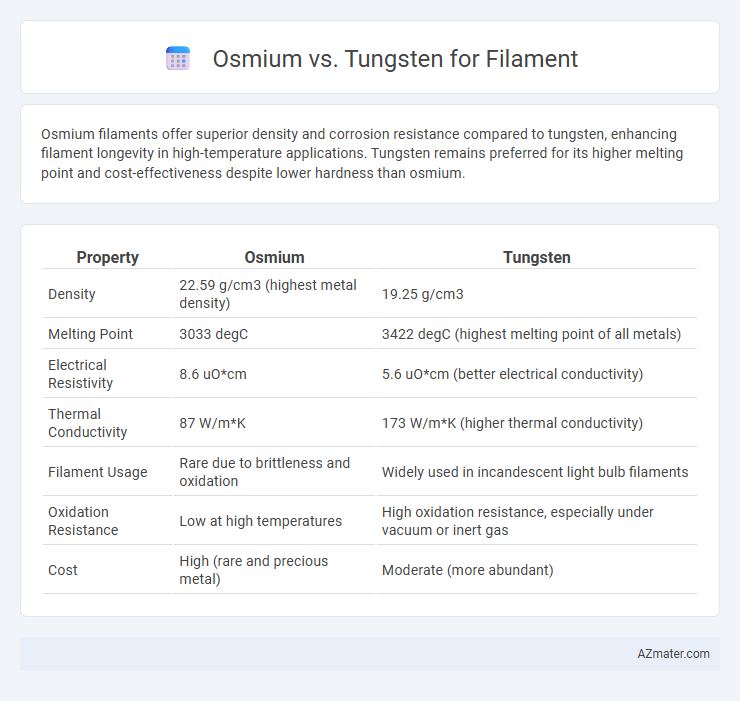Osmium filaments offer superior density and corrosion resistance compared to tungsten, enhancing filament longevity in high-temperature applications. Tungsten remains preferred for its higher melting point and cost-effectiveness despite lower hardness than osmium.
Table of Comparison
| Property | Osmium | Tungsten |
|---|---|---|
| Density | 22.59 g/cm3 (highest metal density) | 19.25 g/cm3 |
| Melting Point | 3033 degC | 3422 degC (highest melting point of all metals) |
| Electrical Resistivity | 8.6 uO*cm | 5.6 uO*cm (better electrical conductivity) |
| Thermal Conductivity | 87 W/m*K | 173 W/m*K (higher thermal conductivity) |
| Filament Usage | Rare due to brittleness and oxidation | Widely used in incandescent light bulb filaments |
| Oxidation Resistance | Low at high temperatures | High oxidation resistance, especially under vacuum or inert gas |
| Cost | High (rare and precious metal) | Moderate (more abundant) |
Introduction to Filament Materials
Osmium and tungsten are both dense, high-melting-point metals commonly considered for filament materials in incandescent lighting and high-temperature applications. Tungsten's melting point of 3422degC and excellent tensile strength make it the industry standard for filaments, providing durability and efficient light emission. Osmium, with a melting point around 3033degC and exceptional hardness, offers potential but is limited by brittleness and scarcity, restricting its widespread use compared to tungsten.
Overview of Osmium and Tungsten
Osmium, a dense and rare transition metal with a bluish-silver hue, offers exceptional hardness and high melting point, making it resistant to wear in filament applications. Tungsten, known for the highest melting point among metals and excellent tensile strength, is widely used in filaments for its durability and ability to operate at extreme temperatures. Both elements provide unique advantages in filament technology, with osmium's density contributing to stability and tungsten's thermal properties ensuring longevity under intense heat.
Historical Use in Light Bulb Filaments
Osmium was one of the first metals used in incandescent light bulb filaments during the early 20th century due to its high melting point and durability. Tungsten later replaced osmium because of its superior melting point of 3422degC, which allowed for higher operating temperatures and greater filament longevity. The transition from osmium to tungsten marked a significant technological advancement in light bulb efficiency and brightness.
Physical and Chemical Properties Comparison
Osmium exhibits a higher density of 22.59 g/cm3 compared to tungsten's 19.25 g/cm3, making it one of the densest metals available for filament use. Tungsten possesses a melting point of 3422degC, significantly exceeding osmium's melting point of approximately 3045degC, which contributes to its superior heat resistance and durability in high-temperature applications. Chemically, tungsten forms a stable oxide layer that resists corrosion, whereas osmium is more prone to oxidation, producing volatile osmium tetroxide, a hazardous compound that limits its practical use in filament manufacturing.
Melting Points: Osmium vs Tungsten
Osmium has a melting point of approximately 3,033degC, which is slightly lower than tungsten's melting point of about 3,422degC, making tungsten the highest melting point metal used in filament applications. Tungsten's superior melting point ensures greater durability and resistance to deformation at extreme temperatures, critical for filament performance in high-heat environments like incandescent bulbs and electron emitters. While osmium boasts exceptional density and hardness, its relatively lower melting point limits its practicality compared to tungsten in high-temperature filament contexts.
Electrical Conductivity Differences
Osmium and tungsten differ significantly in electrical conductivity, impacting their performance as filaments; tungsten exhibits higher electrical conductivity at approximately 1.89 x 10^7 S/m compared to osmium's lower conductivity near 0.6 x 10^7 S/m. This higher conductivity enables tungsten filaments to heat efficiently while maintaining structural integrity at high temperatures, making tungsten the preferred material for incandescent bulbs and electron microscopy filaments. Osmium's lower conductivity results in greater resistive heat generation, limiting its practical use despite its exceptional hardness and density.
Durability and Lifespan in Filament Applications
Osmium and tungsten both exhibit exceptional durability for filament applications, but tungsten outperforms osmium in lifespan due to its higher melting point of 3422degC compared to osmium's 3033degC. The superior thermal stability of tungsten allows filaments to withstand prolonged high-temperature operations without significant degradation. Tungsten's resilience to oxidation at elevated temperatures further extends the functional lifespan of filaments in harsh environments.
Availability and Cost Factors
Osmium is significantly rarer and more expensive than tungsten, making it less practical for filament use despite its high density and durability. Tungsten is widely available and cost-effective, leading to its preference in manufacturing filaments for electrical applications. Cost efficiency and material abundance position tungsten as the dominant choice for filament production over osmium.
Environmental and Safety Considerations
Osmium and tungsten filaments differ significantly in environmental and safety aspects; osmium is less commonly used due to its toxicity and potential to form harmful osmium tetroxide upon oxidation, posing serious health risks. Tungsten, by contrast, is more stable, with a high melting point and low chemical reactivity, making it safer for filament applications and less harmful to the environment. Manufacturing and disposal processes for tungsten filaments also tend to have a lower environmental impact compared to osmium, which requires careful handling and containment to prevent toxic exposure.
Final Verdict: Best Choice for Filaments
Osmium and tungsten are both dense metals with high melting points suitable for filament applications, but tungsten is generally the better choice due to its superior thermal stability and resistance to deformation at high temperatures. Tungsten's melting point of 3422degC far exceeds osmium's 3033degC, allowing it to maintain filament integrity longer under extreme conditions. Its widespread availability and lower cost compared to osmium make tungsten the preferred material for durable, efficient filaments in lighting and industrial uses.

Infographic: Osmium vs Tungsten for Filament
 azmater.com
azmater.com